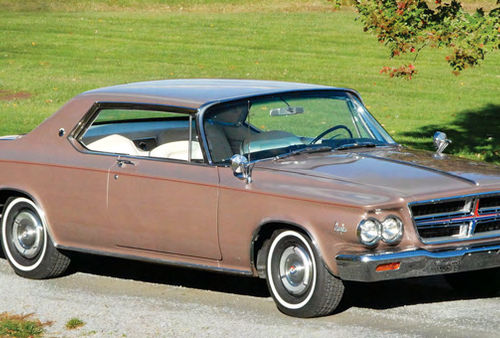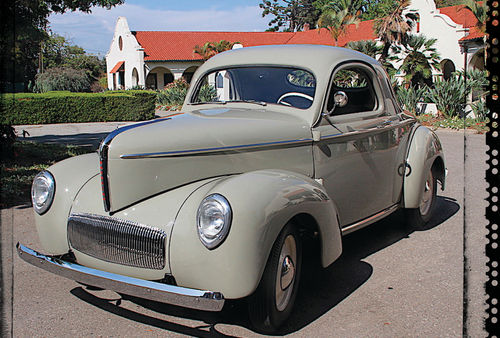1949 Buick Roadmaster Estate Wagon, the Woody
Mack Minton loved ’49 Buicks from the day they first rolled into the dealers’ showrooms. As far as he was concerned, they were beautiful cars. But he never laid eyes on a ’49 Buick Roadmaster Estate Wagon until 1960. Ironically, that introduction took place when the Roadmaster wagon that would one day be his broke down in front of his home. Plenty of other people have probably never seen their first Estate Wagon since Buick only made a total of 2500 station wagons in 1949 — 1847 Supers and 653 Roadmaster Estate Wagons. Differences were few, but the Roadmaster wagons were equipped with larger engines and a longer wheelbase resulting in a longer front clip than the Super models. (The Super had a 248-cubic-inch straight eight while the Roadmaster carried a 320-cubic inch eight.) From the firewall back, the body was the same on both models. The Roadmaster also had carpeted floors, a first for a GM station wagon, and it sported four VentiPorts on its front fenders, compared with the Super’s three.
Because all-metal station wagons were still a couple of years away from production line reality, Buick subcontracted the specially-built bodies to Ionia Manufacturing, a furniture builder in Ionia, Michigan. A combination of Northern Ash and Honduras Mahogany were used in building the bodies. 1949 was the last model year that Buick used wood interior door panels.

Our featured Roadmaster Estate Wagon was delivered in 1949 to Krell Buick in Pasadena, California. It was used by the dealership’s owner as his personal car and dealer demo. Krell sold it to the Snider family of Eagle Rock, California, in 1950.

It was a broken axle that disabled this car in front of Minton’s house that fateful day in 1960. When the tow truck came to the rescue, Minton followed it to the garage and checked the registration paperwork that was attached to the steering column (common practice in those days) to see who owned it. After building up enough courage, he drove to the Snider’s house and asked if they wanted to sell their Roadmaster. The Sniders were interested in getting a new wagon, but were not in a rush. Minton persisted for two years. Finally, in January1962, the Sniders sold their 55,000 mile Roadmaster to Minton for $200. ‘It was the find of a lifetime.” Minton said.
Minton quickly took his prize home and garaged it. Unlike many Woodies, it had been well cared for and needed little to bring it back to its original glory. It had always been garaged and each year the Sniders followed the owner’s manual recommendations and varnished the wood. But while 12 years of varnish had preserved the wood, the buildup had yellowed, masking its true beauty. Furthermore, the body had a few small dents and was in need of a fresh coat of paint.
The first thing Minton did was strip and refinish the wood. The natural beauty of the Northern Ash came to life.
In July of ’62, Minton removed the chrome and delivered his Roadmaster to a body shop for paint.
They did the body work and painted it with acrylic lacquer. A final clear coat was added, giving the paint a “candy apple” look, popular in the early 60s. Minton had the bumpers replated and was able to get new side stainless moldings from the Buick dealer. Although it was not his primary car, Minton put more than 10,000 miles on his Roadmaster the first year. “I couldn't leave it alone!” he admitted.
In 1966 the stitching began coming out of the original seats, so Minton had the interior redone. The original seats were simple, leatherIe “Seat frames Buick used were also used as covered bench seats on buses. This is evidenced by the chrome rail around the seat backs. Minton had the seats recovered in the same cream-colored leather. He asked the upholsterer to add a few “biscuits and buttons” to the cushions, as he considered the original seats to be rather uninteresting. The interior wood, with the exception of the tailgate, is the original factory finish. The door panels are made of Honduras Mahogany and _ have three cream-colored horizontal pinstripes across them and a carpeted lower section.

By 1971 Minton’s Roadmaster was in need of another paint job. The multiple coats of lacquer applied in 1962 were crazing and cracking. The wood needed to be refinished again, too. Minton first stripped the wood by sanding. “You sand until the ash is a beautiful snow white — then you know it’s clear of everything.” Following the sanding, a filler is used across the grain and then a sealer is added. The final process is the finish coat, but Minton wanted to wait until after the paint was complete. He was concerned that the large amount of masking tape would damage the wood’s finish. “If the sealer is damaged it’s easy to reseal,” he said.

Minton asked his automotive mentor to paint the car, but he declined due to health reasons. “If you're willing to do the work,” he told Minton, “I'll tell you what to do.” “He coached and I worked,” Minton recalls.

Minton used a chemical stripper to remove the paint. He had to remove the clear and base coats which had been applied in 1962, as well as the original paint which was under both of those. Minton was told to leave as much of the original black primer as possible. It resisted the stripper and about 60 percent of the original primer survived. Minton primed the Roadmaster and then applied 12 coats of Duco teal-colored nitrocellulose lacquer. After hand rubbing the teal lacquer to a high gloss, he added the finish coat to the wood.
All of the wood on this Roadmaster is original. Over the years Minton has refinished the wood seven times, experimenting with all types of finishes with varying degrees of success. At the time these cars were manufactured, clear lacquer was sprayed on the wood.
Minton never wanted to spray on the wood’s finish, because of the excessive amount of masking required. Over the years he has used various types of brushing varnish and once used a polyurethane, which he recalls as a disaster. Two years ago Minton did the most recent wood refinish. He used a clear brushing enamel with which he’s very happy.
The straight-eight engine and Dynaflow transmission have never been out of this car. In 1969 Minton had the valves ground and admits the engine should be rebuilt — it’s starting to puff a little smoke. The Dynaflow has worked flawlessly over the years, requiring only an occasional seal replacement to fix a leak. “If I drove it more, the seals wouldn't dry out,” says Minton. He also takes exception to those who sneer at the Dynaflow as being a slush box. He feels most Dynaflow-equipped cars were under-powered, thereby giving the transmission a bad rap. Minton’s Roadmaster cruises easily with any car of the ’90s.

In sum, this car is a testament to the value of regular maintenance and owner attention. Jack Minton doesn’t claim to have restored his Roadmaster. It’s been “freshened up twice,” as he puts it, but more importantly it’s been given a steady diet of loving care for the past three decades.

Down to the Sea in Woodies.
Moe Beach in Encinitas, California, is the gathering place for Wavecrest, the nation’s largest annual Woodie show. In the most recent meet, held last September, more than 200 wood-sided cars converged for the 16th annual meet. Owners from all over the country and Canada gathered to swap stories and sniff spar varnish. Wavecrest is free to the public and free to participants. The only requirement is that the cars entered must have real wood on the sides.

The Woodie was the first incarnation of what we recognize as a station wagon. The term “station wagon” was coined to describe a car used to transport people and their baggage to and from the train station. The early station wagons were standard passenger cars modified by elongating the body and adding a tailgate. Since auto manufacturers were unwilling to tool-up for an all-steel body on a low-production vehicle like the station wagon, they sub-contracted the work to local coach builders who used wood to construct the body.
Woodies were beautiful, but not very durable. Weather, time and termites took their toll on the wood. Real wood fell out of favor in the early ’50s to be replaced by steel painted to look like wood, and even worse, plastic.
















